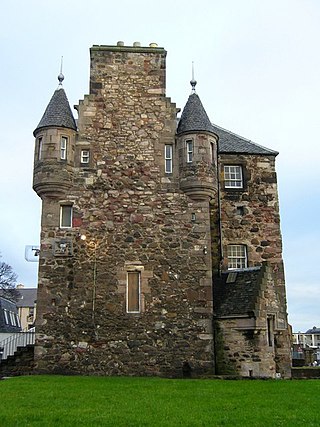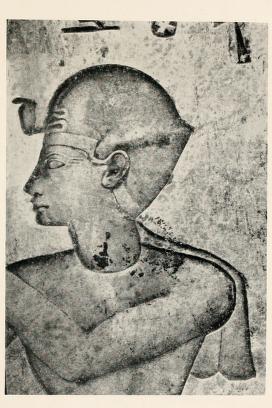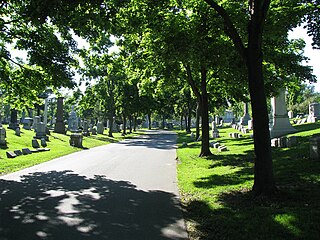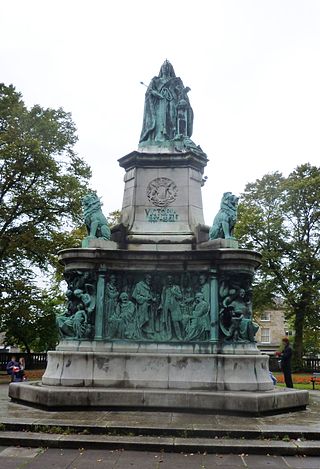
The Mausoleum at Halicarnassus or Tomb of Mausolus was a tomb built between 353 and 350 BC in Halicarnassus for Mausolus, an Anatolian from Caria and a satrap in the Achaemenid Empire, and his sister-wife Artemisia II of Caria. The structure was designed by the Greek architects Satyros and Pythius of Priene. Its elevated tomb structure is derived from the tombs of neighbouring Lycia, a territory Mausolus had invaded and annexed c. 360 BC, such as the Nereid Monument.

Thutmose III, sometimes called Thutmose the Great, was the sixth pharaoh of the 18th Dynasty. Officially he ruled Egypt from 28 April 1479 BC until 11 March 1425 BC, commencing with his coronation at the age of two and concluding with his death, aged fifty-six; however, during the first 22 years of his reign, he was coregent with his stepmother and aunt, Hatshepsut, who was named the pharaoh. While he was shown first on surviving monuments, both were assigned the usual royal names and insignia and neither is given any obvious seniority over the other. Thutmose served as the head of Hatshepsut's armies. During the final two years of his reign, he appointed his son and successor, Amenhotep II, as his junior co-regent. His firstborn son and heir to the throne, Amenemhat, predeceased Thutmose III.

Abu Simbel is a historic site comprising two massive rock-cut temples in the village of Abu Simbel, Aswan Governorate, Upper Egypt, near the border with Sudan. It is located on the western bank of Lake Nasser, about 230 km (140 mi) southwest of Aswan. The twin temples were originally carved out of the mountainside in the 13th century BC, during the 19th Dynasty reign of the Pharaoh Ramesses II. Their huge external rock relief figures of Ramesses II have become iconic. His wife, Nefertari, and children can be seen in smaller figures by his feet. Sculptures inside the Great Temple commemorate Ramesses II's heroic leadership at the Battle of Kadesh.

The Soldiers and Sailors Monument is a monument erected in Boston Common in downtown Boston, dedicated to soldiers and sailors of the Commonwealth of Massachusetts who died in the American Civil War. Designed by Martin Milmore, construction began in 1874 and the monument was dedicated on September 17, 1877. Union Generals George B. McClellan and Joseph Hooker were among the estimated 25,000 people attending the dedication on Boston Common.

Anıtkabir is a complex located in the Çankaya district of Ankara, which includes the mausoleum of Mustafa Kemal Atatürk. Designed by Emin Onat and Orhan Arda, the construction of Anıtkabir began in 1944 and was completed in 1953. In addition to the mausoleum building, the complex consists of various structures and monuments, as well as a wooded area known as the Peace Park.

The Red Chapel of Hatshepsut or the Chapelle rouge was a religious shrine in Ancient Egypt.

Craigentinny is a suburb in the north-east of Edinburgh, Scotland, east of Restalrig and close to Portobello.

Neterkheperre or Netjerkheperre-Setepenamun Siamun was the sixth pharaoh of Egypt during the Twenty-first Dynasty. He built extensively in Lower Egypt for a king of the Third Intermediate Period and is regarded as one of the most powerful rulers of the Twenty-first Dynasty after Psusennes I. Siamun's prenomen, Netjerkheperre-Setepenamun, means "Divine is The Manifestation of Ra, Chosen of Amun" while his name means 'son of Amun.'

Forest Lawn Cemetery is a historic rural cemetery in Buffalo, New York, founded in 1849 by Charles E. Clarke. It covers over 269 acres (1.1 km2) and over 152,000 are buried there, including U.S. President Millard Fillmore, First Lady Abigail Fillmore, singer Rick James, Congresswoman Shirley Chisholm, and inventors Lawrence Dale Bell and Willis Carrier. Forest Lawn is on the National Register of Historic Places.

Restalrig is a small residential suburb of Edinburgh, Scotland. It is located east of the city centre, west of Craigentinny and to the east of Lochend, both of which it overlaps. Restalrig Road is the main route through the area, running from London Road, at Jock's Lodge, to Leith Links. It is in the ward of Lochend.

Architectural sculpture is the use of sculptural techniques by an architect and/or sculptor in the design of a building, bridge, mausoleum or other such project. The sculpture is usually integrated with the structure, but freestanding works that are part of the original design are also considered to be architectural sculpture. The concept overlaps with, or is a subset of, monumental sculpture.

The Cappella Colleoni is a chapel and mausoleum attached to the Basilica of St. Mary Major in the northern Italian city of Bergamo.

The Confederate Monument of Bowling Green, in Bowling Green, Kentucky, is among the sixty-one monuments of the Civil War Monuments of Kentucky Multiple Property Submission, all of which became part of the National Register of Historic Places on July 17, 1997. It is within Bowling Green's Fairview Cemetery, on the east side of the old/northern side of the cemetery.

William Henry Miller was a Scottish book collector and parliamentarian. He sat in the House of Commons from 1830 to 1837.
Alfred-Alphonse Bottiau was a French sculptor. He was born in Valenciennes and after early studies in his home town he studied in Paris under Jean Antoine Injalbert and was runner-up for the Prix de Rome for sculpture in 1919. Bottiau had joined the army in 1910 and served until 1919. He was director of the Écoles Académiques de Valenciennes from 1946 to 1951.

The General William Tecumseh Sherman Monument is an equestrian statue of American Civil War Major General William Tecumseh Sherman located in Sherman Plaza, which is part of President's Park in Washington, D.C., in the United States. The selection of an artist in 1896 to design the monument was highly controversial. During the monument's design phase, artist Carl Rohl-Smith died, and his memorial was finished by a number of other sculptors. The Sherman statue was unveiled in 1903. It is a contributing property to the Civil War Monuments in Washington, D.C. and to the President's Park South, both of which are historic sites listed on the National Register of Historic Places.
Alfred Gatley was an English sculptor.

The Queen Victoria Memorial in Lancaster, Lancashire, England, is a Grade II* listed building. It stands in the centre of Dalton Square, Lancaster facing Lancaster Town Hall. It was erected in 1906, being commissioned and paid for by James Williamson, 1st Baron Ashton.

The Royal Mausoleum is a mausoleum for Queen Victoria and her husband Prince Albert, Prince Consort. It is located on the Frogmore estate within the Home Park at Windsor in Berkshire, England. It was listed Grade I on the National Heritage List for England in October 1975. Built between 1862 and 1871, Albert, who died in 1861, was interred in the mausoleum in 1871 following its completion. Victoria was interred on 4 February 1901 following her death in late January.



















